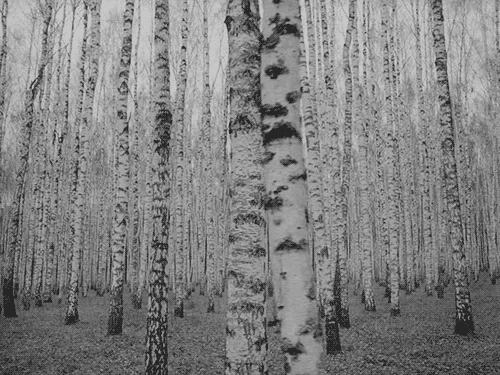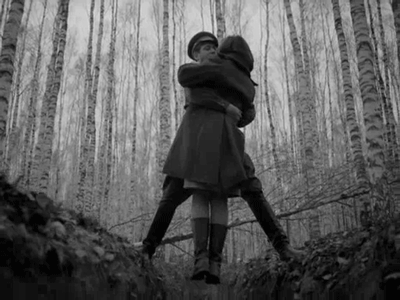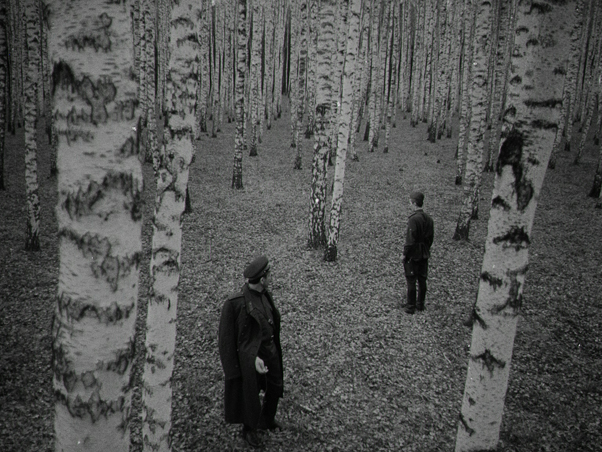For a film about war, Ivan’s Childhood (1962) by Andrei Tarkovsky dwells quite unexpectedly upon the natural landscape of its narrative. At first, this might seem somewhat unsurprising; after all, most films set during war often make use of the battered terrain of the landscape, if only to show the fallout and power of the weaponry available. Ivan’s Childhood does more than this and contains many a hint towards where Tarkovsky would go in future films in regards to the importance of the landscape within his work and its effects upon his characters.
The film is set on the eastern front during the Second World War and follows a young boy named Ivan (Nikolay Burlyaev). He is working as a spy for the Russians due to his small and agile nature which allows him to cross the treacherous border with far greater ease than an older man. This border within the film is made up of the first and last sets of forest that the viewer sees and begins a collection of different tree-based visual motifs that reoccur throughout the film. This forest is in the very centre of the battlefield and its trees are scarred. The land is submerged in water and the foliage left stands to show the decimation of the place due to the fighting.

Interestingly, the trees here are used in a symbolic sense to grow out of the chaos, showing the pointlessness of the fighting by defying even the most harsh of circumstances; people may not be able to cope within the environment any more but the trees can. It’s an aspect that would become typical in Tarkovsky’s later films where the environment explicitly outlives the people, or at the very least outlives their desire to live within it. The Zone in Stalker (1979) is a good example of this as well as the house in The Sacrifice (1986) and the derelict, overgrown cathedral in Nostalgia (1983).
This image is contrasted later on in Ivan’s Childhood with one of the film’s most famous images; that of Ivan himself framed within the charred and broken remains of a wooden hut. This is the image used to sell the film as a cover for the Criterion Collection DVD and so its importance in surmising the film is at least palpable even before analysis. Yet, to contextualise it with the opening images of trees, Tarkovsky is implying nature’s capacity for rejuvenation. Even when the trees have been cut and used for man-made purchase, they still outlive the people who use them as shelter, especially in times when humans are insistent upon killing each other.

By framing Ivan in such a way, Tarkovsky is also laying blame upon the older generation but showing the potential moral and physical re-growth through the young. Not only is Ivan the only one who can actually make it through this new terrain, he is also the only one who appears to understand the basic reversal of process that the wildness of place has when the people of the area are removed.
Tarkovsky also has another use for forests in the film but one that is of an entirely different proposition. Away from the main battle is a forest shown to be predominantly made up of silver birch trees; their white bark giving this particular forest a strangely ghostly and empty appeal. This place is away from battle and near a battalion station meaning it becomes an area for tranquil relaxing and other, more social activities. Officers take walks within it and one in particular attempts to woo one of the nurses with a walk through its endless cacophony of branches.

This gives rise to another of the film’s famous scenes; where the officer in particular helps the nurse across a gap in the forest, only to use her vulnerability while in midair to kiss her. As she hangs almost limp above the gap, the camera moves downwards into the ground allowing the couple to be framed within the trees almost as if their expression of emotion means they become part of the forest itself. This is upturned when, to politely escape the officer’s intentions, the nurse climbs high upon the bark of a fallen tree; the scene is again itself a reversal only this time of something that the film had already created. In this sense, Tarkovsky shows the forest to be an area of duality, of both entrapment and escape.

Ivan’s Childhood provides a number of different uses for the symbolic image of the forest. It’s particularly telling that, during the film’s final dream sequence, Ivan’s happiness is suggested through the presence of a beach with only a single tree in its geography. Perhaps Tarkovsky wanted to show the necessity of the trees as a hopeful presence within the darker times of human brutality; a silver birched lining that seems inherently necessary when life is devoid of currency and meaning.
Adam Scovell



One thought on “The Forests Of Ivan’s Childhood (1962) – Andrei Tarkovsky.”